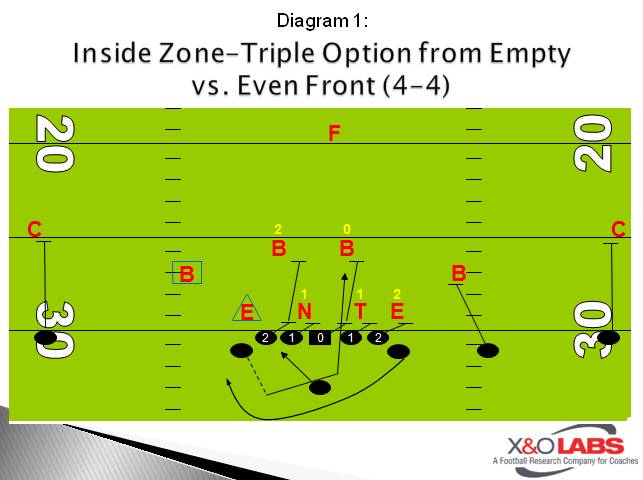By Cory Kitchen
Offensive Coordinator/Quarterbacks Coach
Fort Wayne Bishop Dwenger High School (IN)
Twitter: @ckitchen11
Introduction:
The Triple Option has been a staple at Bishop Dwenger High School for more than a decade. We have found that running Inside Zone-Triple Option from an Empty formation is a way to modernize an old-school scheme. This clinic report will discuss how we run this concept, as well as introduce a complimentary “QB Wham” run and an explosive “Stretch” play action pass, all from the same Empty Triple Option look.
Inside Zone – Triple Option
We try to make things as simple as possible for our players so they can react and play fast without having to think about their assignment. We believe “if you think, you stink.” Our Inside Zone scheme fits that premise as we use a simple “Count System” with our offensive line. Pre-snap, the Center will identify the A gap defender on the play side as “0”, and our other linemen will count off from there.
In Diagram #1, you will see our offense against an Even Front. In this scenario, the Center will identify the play side ILB as the “0”, since he is the play side A gap defender. The Center is responsible for the “0”. The right guard is responsible for the play side B gap defender, or the “1”, which in this case is the 3 technique. Finally, the right tackle is responsible for the play side C gap defender, or the “2”, which in this case is the play side DE. On the weak side, the LG is responsible for the weak side A gap defender, or the weak side “1”, which in this case is the 1 technique. The left tackle is responsible for the weak side B gap defender, which is the weak side ILB. The weak side DE is our unblocked handoff key, and the weak side OLB is our unblocked pitch key for our Triple Option.

As you can see from the diagram, once our offensive linemen get comfortable with their blocking assignments in the count system, we allow them freedom to communicate with their fellow linemen. They can decide to combo-block up front, in case the defenders swap gap responsibilities. If the zone blocking schemes are new to you, we would recommend teaching the “count system” as a man scheme first, then working your way up to combination blocks as your linemen get comfortable with it.
We ask our dive back to begin his orbit motion, then come across the QB’s face upon the snap of the ball. If given the ball, he will continue pressing horizontally until he finds daylight, then will stick his back foot in the ground and get vertical. The play side A gap is his hopeful aiming point, but he will cut anywhere he can find daylight. The QB will catch the ball, step off the mid-line and stare down the handoff key, in this case the weak side DE. We teach him to “give” unless he believes the hand-off key can make the tackle on our dive back. If the QB pulls it, he is instructed to replace the feet of the handoff key and attack the inside shoulder of the pitch key. If the pitch key turns his shoulders toward the QB, he will “come to balance”, step to his pitch man, and deliver the pitch. We teach a “heart to heart” pitch technique. The ideal pitch relationship should be 5 yards between the QB and the pitch man, and 1 yard behind the QB.
Diagram 2 (below) shows the Inside Zone-Triple Option play against an Odd front. Again, using the “count system”, the Center identifies the 0 technique Nose Guard as the A gap defender. The right Guard is responsible for the B gap defender, or the play side “1”, which in this case is the play side ILB. The Right Tackle is responsible for the play side B gap defender, or the “2”, which is the 4 technique DE. On the weak side, the Left Guard is responsible for the weak side A gap defender, or the weak side “1”, which is the weak side ILB. Since the weak side 4 technique DE is the handoff key and the weak side OLB is the pitch key, there is not a “2” for our Left Tackle to block versus this Odd front. In this case, we tell our Left Tackle to release inside to the weak side ILB and perform a “Veer Block” to seal off the backside for the QB or a RB cut back.









